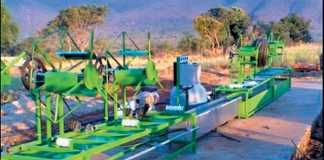
The prospect of nutraceuticals in swine nutrition as a viable alternative to antibiotic growth promoters (AGPs) was highlighted at a pig vets forum hosted in Johannesburg recently by global animal feed company Biomin. Dr Thomas Volker, guest speaker at the event, noted that the global agricultural livestock industry has been under pressure in recent years as grain prices soar.
“With financial constraints and limited avenues open to them, farmers are under greater pressure to apply the technology and research currently available to improve efficiency and maximise profit in the long term,” he explained. He indicated there was an increasing number of products and newly developed technologies available on the local market. These developments have raised the question: antibiotic growth promoters (AGPs) or nutraceuticals?
In the application of antibiotics, Dr Volker said the main function was the suppression of harmful bacteria to ensure that beneficial bacteria, which aid with fermentation and digestion, can grow and increase in number. “One assumes that if antibiotics are applied, harmful bacteria will be suppressed and good bacteria in the gut will proliferate.
“However, antibiotics are non-selective, and kill all gram-positive bacteria, regardless of whether they are good or bad.”
Probiotics are bacteria that are essential in improving digestion. To make a brief distinction between the two – antibiotics are a veterinary subject and probiotics are a nutritional subject. According to Volker, probiotics have been relatively uncommon until recently due to costs.
“Based on a cost-per-ton calculation, adding AGPs to feed has been historically cheaper than adding probiotics. This is rapidly changing and, in Europe for example, enormous quantities of feed now contain probiotics.” Volker points out that antibiotics have no direct effect on digestion. The effect is indirect in that they suppress unwanted bacteria. “In probiotics digestion is enhanced as the bacteria added in larger quantities produce enzymes that improve the digestion and absorption of food.”
Gut physiology at weaning
During the post-weaning period, there is a marked reduction of voluntary feed intake (VFI), with a minimum of 30% to 40% of piglets not eating at all. One challenge is to get these piglets to eat, as the effect on the villi in the lumen is more marked than in pigs that do eat. Dr Volker adds: “There is a dramatic change in the gut lumen which affects digestion, health and immunity of the piglet. This ultimately leads to poor growth and development and can also result in diarrhoea, which in turn increases susceptibility to various other harmful disease causing bacteria such as E. coli.”
If a decision needs to be made on what to feed the piglets, Dr Volker stresses that it is critical to identify every raw material in the feed, as this makes the difference between digestion and non-digestion. “Probiotics can help piglets cope better in stressful situations in combination with prebiotics and organic acids.”
A prebiotic is a non-digestible food ingredient that beneficially affects the host by stimulating the growth of good bacteria. Prebiotics added to feed helps good bacteria grow faster. If a prebiotic only is used, it is assumed that the pigs have the correct microbiota. Chicory pulp, beetroot pulp, insulin and fermentable carbohydrates such as lactose are examples of prebiotics.
Organic acids
Dr Volker explains that organic acids have a growth promoting effect on pigs and are used as an alternative to AGPs. “The acids diffuse through the cell membrane of the intestinal lumen and with the cytoplasm they combine to kill off ‘bad’ bacteria.” Examples of such organic acids are formic acid, acetic, proprionic and butyric acids – or a combination of these acids.
“Acetic, proprionic and butyric acids are major end products of fibre digestion in the hind gut. They enhance natural products in the gut, while the low pH suppresses the multiplication of bacteria. The piglet then has a better chance of good bacteria proliferating.” Dr Volker adds that these different acids have different functions. “Acetic acid inhibits the growth of bacteria, proprionic acid inhibits the growth of moulds and lactic acid also inhibits the growth of bacteria. Organic acids enhance palatability and the growth of gut epithelium.”
Dr Volker sounds a cautionary note on the dose rate: “5kg/t is optimal. Increasing that dosage will actually increase the risk of the feed becoming less palatable, the pH will drop too far and intakes will decrease. Some acids enhance the absorption of antibiotics. The greatest benefit is seen in diets composed of cereals and plant protein,” he continues.
In pre- and post-weaning, Volker advises that it’s vital to include prebiotics, probiotics and organic acids to stabilise piglet health and to obtain even growth.
“In grower and sow diets, marked differences have been observed. Prebiotic, probiotic and organic acids should be applied to pig diets for their different roles, as they improve food conversion. What’s more, these additives have received a minimal amount of negative feedback from the industry, and the positive advantages of using prebiotics, probiotics and organic acids far outweigh the disadvantages,” he concludes. – Mary- Anne O’Donnell.
Contact Dr Thomas Volker on 034 995 9954 or email [email protected].












